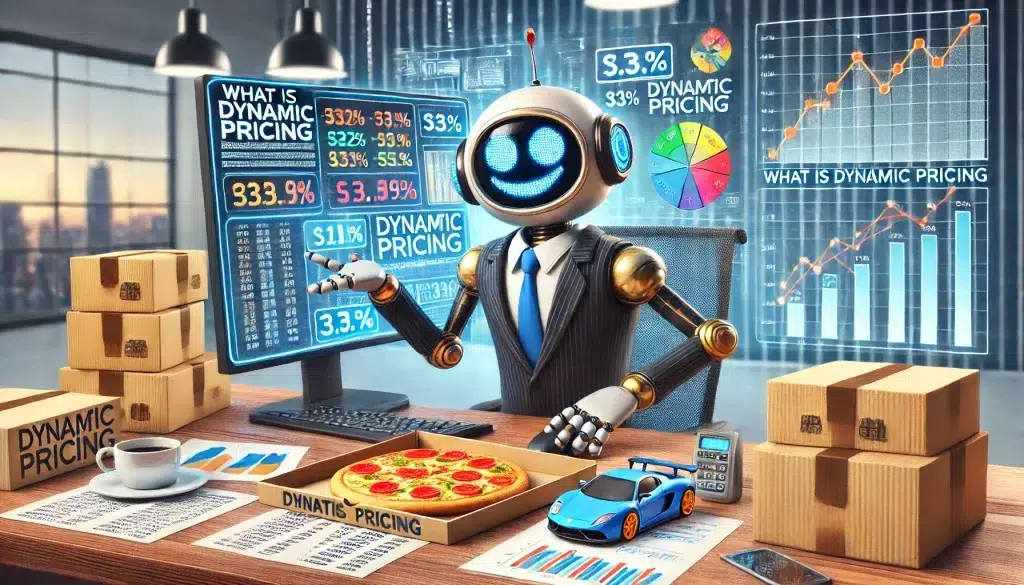
Dynamic pricing is the game-changing strategy that’s revolutionizing the way businesses set their prices. In a nutshell, it’s a pricing approach where companies adjust the cost of their products or services in real-time based on market demand, supply fluctuations, competitor pricing, and other relevant factors. This flexible pricing model allows businesses to stay agile in today’s fast-paced market, maximizing revenue while offering competitive prices to customers.
Table of Contents
- Introduction to Dynamic Pricing
- How Does Dynamic Pricing Work?
- Types of Dynamic Pricing Strategies
- Benefits of Dynamic Pricing
- Challenges and Disadvantages
- Dynamic Pricing vs. Static Pricing
- Industries Using Dynamic Pricing
- Dynamic Pricing Algorithms and Machine Learning
- Implementing Dynamic Pricing in Your Business
- The Future of Dynamic Pricing
- How Pricefy Can Help with Dynamic Pricing
- My Experience with Dynamic Pricing
- Conclusion
- Useful Links
Introduction to Dynamic Pricing
Dynamic pricing, also known as surge pricing, demand-based pricing, or real-time pricing, is not just a buzzword – it’s a powerful tool that’s reshaping the business landscape. This pricing model allows companies to be as fluid as the market itself, adapting prices on the fly to maximize profitability and stay competitive.
But don’t be fooled into thinking this is a new concept. Dynamic pricing has been around for centuries, particularly in industries like hospitality and travel. However, the advent of big data, machine learning, and advanced analytics has supercharged this strategy, making it more sophisticated and widely adopted across various sectors.
How Does Dynamic Pricing Work?
Now, let’s dive into the nitty-gritty of how dynamic pricing operates. It’s not magic – it’s a data-driven process that involves continuous analysis of various factors influencing supply and demand. Here’s a step-by-step breakdown of the dynamic pricing dance:
Data Collection: The process kicks off by gathering a treasure trove of relevant data, including:
- Current demand levels
- Available inventory
- Competitor pricing
- Historical sales data
- Time and date
- Special events or holidays
- Weather conditions (for certain industries)
- Customer segments and behaviors
Data Analysis: Advanced algorithms crunch these numbers, identifying patterns and trends faster than you can say “price optimization.”
Price Calculation: Based on this analysis, the optimal price is calculated with lightning speed.
Price Update: The new price is automatically updated across all relevant platforms – website, app, in-store displays – you name it.
Monitoring and Adjustment: The system keeps a watchful eye on the impact of the new price, making further adjustments as needed.
This process happens in real-time, allowing businesses to ride the waves of market changes with unprecedented agility.
Types of Dynamic Pricing Strategies
Dynamic pricing isn’t a one-size-fits-all solution. There are several flavors of this strategy that businesses can employ:
- Time-Based Pricing: Prices fluctuate based on the time of day, week, or season. Think of how hotel rooms often cost more during peak travel seasons.
- Segmented Pricing: Different prices for different folks! This strategy offers varied prices to different customer segments based on their willingness to pay or other characteristics.
- Peak Pricing: When demand skyrockets, so do the prices. Ride-sharing services often use this strategy during rush hours or special events.
- Penetration Pricing: Start low, aim high. This strategy involves setting initially low prices to gain market share, then gradually increasing them over time.
- Competitor-Based Pricing: Keep your friends close and your competitors closer. This approach involves adjusting prices based on what the competition is doing.
- Bundle Pricing: The more, the merrier! This strategy offers discounts on product bundles to encourage larger purchases.
- Geographical Pricing: Location, location, location. Prices vary based on where the customer is located.
Benefits of Dynamic Pricing
Dynamic pricing isn’t just a fancy term – it’s a powerhouse strategy that offers numerous advantages for businesses:
- Revenue Boost: By optimizing prices based on demand, businesses can maximize their revenue potential. Ka-ching!
- Inventory Management on Steroids: Dynamic pricing helps balance supply and demand, reducing the risk of overstocking or stockouts.
- Competitive Edge: The ability to adjust prices at the drop of a hat allows businesses to stay ahead in fast-moving markets.
- Customer Segmentation 2.0: Dynamic pricing enables businesses to offer different prices to different customer segments, potentially increasing overall sales.
- Data-Driven Decision Making: The wealth of data collected for dynamic pricing can inform other business decisions, making you smarter by the minute.
According to a study by McKinsey & Company, companies that use dynamic pricing can increase their margins by a whopping 5-10% within just a few months. Now that’s what we call a game-changer!
Challenges and Disadvantages
While dynamic pricing might seem like the holy grail of pricing strategies, it’s not without its challenges:
- Customer Perception: Some customers might view frequent price changes as unfair or manipulative. Transparency is key!
- Implementation Complexity: Setting up a dynamic pricing system isn’t a walk in the park – it requires significant technological investment and expertise.
- Data Quality: Your dynamic pricing strategy is only as good as the data you feed it. Garbage in, garbage out!
- Regulatory Concerns: In some industries, dynamic pricing may face legal or regulatory hurdles. Always do your homework!
- Competitive Pressure: If not managed carefully, dynamic pricing can lead to price wars with competitors. Nobody wants a race to the bottom!
Dynamic Pricing vs. Static Pricing
To truly appreciate dynamic pricing, let’s pit it against its traditional counterpart, static pricing:
| Aspect | Dynamic Pricing | Static Pricing |
|---|---|---|
| Price Changes | Frequent, sometimes in real-time | Infrequent, typically at set intervals |
| Flexibility | High | Low |
| Complexity | High | Low |
| Data Requirements | Extensive | Minimal |
| Potential Revenue Optimization | High | Limited |
| Customer Predictability | Low | High |
| Implementation Cost | High | Low |
Industries Using Dynamic Pricing

Dynamic pricing has spread its wings across various industries:
- Airline Industry: The OG of dynamic pricing, airlines adjust ticket prices based on demand, time until departure, and competitor pricing.
- Hospitality: Hotels use dynamic pricing to optimize room rates based on occupancy, seasonality, and local events.
- E-commerce: Online retail giants like Amazon use dynamic pricing to adjust prices based on demand, inventory levels, and competitor pricing.
- Ride-Sharing: Companies like Uber and Lyft use surge pricing during peak demand periods.
- Entertainment: Ticket prices for events and attractions often vary based on demand and timing.
- Retail: Brick-and-mortar stores are jumping on the dynamic pricing bandwagon, especially with the use of electronic shelf labels.
- Energy Sector: Utility companies use dynamic pricing to manage demand during peak usage times.
Dynamic Pricing Algorithms and Machine Learning
The secret sauce of modern dynamic pricing systems lies in sophisticated algorithms and machine learning models. These technologies enable businesses to process vast amounts of data and make pricing decisions faster than you can say “price optimization.”
Key ingredients of dynamic pricing algorithms include:
- Demand Forecasting: Predicting future demand based on historical data and current trends.
- Price Elasticity Modeling: Understanding how price changes affect demand for different products or services.
- Competitor Analysis: Keeping a watchful eye on competitor pricing strategies.
- Customer Segmentation: Identifying different customer groups and their price sensitivities.
- Optimization Algorithms: Determining the optimal price to maximize a specific objective (e.g., revenue, profit, market share).
Machine learning takes these algorithms to the next level by continuously improving their accuracy based on new data. A study published in the Journal of Revenue and Pricing Management found that machine learning algorithms can improve pricing decisions by up to 25% compared to traditional methods. Now that’s what we call smart pricing!
Implementing Dynamic Pricing in Your Business

Ready to dive into the world of dynamic pricing? Here’s your roadmap:
- Assess Your Readiness: Evaluate if your business has the necessary data, technology, and resources to implement dynamic pricing.
- Define Your Objectives: Clearly outline what you want to achieve with dynamic pricing (e.g., increased revenue, better inventory management).
- Gather and Analyze Data: Collect relevant data on your products, customers, and market conditions.
- Choose a Dynamic Pricing Strategy: Select the strategy that best fits your business model and objectives.
- Invest in Technology: Implement the necessary software and systems to support dynamic pricing.
- Start Small: Begin with a pilot program on a limited selection of products or services.
- Monitor and Adjust: Continuously monitor the results of your dynamic pricing strategy and make adjustments as needed.
- Communicate with Customers: Be transparent about your pricing strategy to maintain customer trust.
The Future of Dynamic Pricing
Hold onto your hats, folks – the future of dynamic pricing is looking bright! Here are some trends shaping its evolution:
- Hyper-Personalization: Dynamic pricing is becoming more personalized, with prices tailored to individual customers based on their behavior and preferences.
- AI and Machine Learning on Steroids: Artificial intelligence and machine learning will continue to supercharge the accuracy and effectiveness of dynamic pricing algorithms.
- IoT Integration: The Internet of Things (IoT) will provide more data points for dynamic pricing decisions, especially in retail and manufacturing.
- Ethical Considerations: As dynamic pricing becomes more prevalent, there will be increased focus on ensuring fairness and transparency in pricing practices.
- Blockchain Revolution: Blockchain could potentially be used to create more transparent and secure dynamic pricing systems.
According to a report by Market Research Future, the global dynamic pricing software market is expected to grow at a jaw-dropping CAGR of 16.2% from 2020 to 2026, reaching a market value of $5.8 billion by 2026. Talk about a pricing revolution!
How Pricefy Can Help with Dynamic Pricing
Enter Pricefy – your secret weapon in the world of dynamic pricing. This cutting-edge dynamic pricing software solution is designed to help businesses of all sizes implement and optimize their pricing strategies.
With Pricefy, you can:
- Effortlessly collect and analyze relevant market data
- Implement sophisticated pricing algorithms tailored to your business needs
- Monitor competitor pricing in real-time
- Conduct A/B testing to fine-tune your pricing strategies
- Generate detailed reports and insights to inform your pricing decisions
Pricefy’s user-friendly interface and robust features make it an ideal choice for businesses looking to leverage the power of dynamic pricing without the need for a Ph.D. in data science.
My Experience with Dynamic Pricing
As a pricing strategy consultant, I’ve had the opportunity to witness the transformative power of dynamic pricing firsthand. One particularly memorable experience was working with a mid-sized e-commerce company that was struggling to compete with larger players in the market.
We implemented a dynamic pricing strategy that took into account not only competitor prices but also customer behavior and inventory levels. The results were nothing short of spectacular. Within three months, the company saw a 15% increase in revenue and a 7% improvement in profit margins.
But it wasn’t all smooth sailing. We faced challenges in communicating the new pricing strategy to customers and had to invest significant resources in upgrading the company’s IT infrastructure. However, the long-term benefits far outweighed the initial hurdles.
This experience taught me that while dynamic pricing can be a powerful tool, it requires careful planning, robust technology, and a commitment to transparency to truly succeed.
Conclusion
Dynamic pricing is more than just a buzzword – it’s a powerful strategy that allows businesses to optimize their pricing in real-time based on market conditions, demand, and other relevant factors. While it offers significant benefits in terms of revenue optimization and competitiveness, it also comes with challenges related to implementation and customer perception.
As technology continues to advance, dynamic pricing is becoming more sophisticated and widely adopted across various industries. Businesses that can effectively implement dynamic pricing strategies are likely to gain a significant competitive advantage in today’s fast-paced, data-driven market.
Whether you’re considering implementing dynamic pricing or looking to optimize your existing strategy, it’s crucial to carefully evaluate your business needs, invest in the right technology, and maintain a balance between profit optimization and customer satisfaction.
Remember, in the world of pricing, the only constant is change. So why not make that change work for you?
Useful Links
For more information on dynamic pricing, check out these authoritative sources:
- Harvard Business Review: How to Use Dynamic Pricing to Your Advantage
- MIT Sloan Management Review: Is It Time to Rethink Your Pricing Strategy?
- McKinsey & Company: Pricing in Retail: Setting Strategy
- Journal of Revenue and Pricing Management
- Pricefy – Dynamic Pricing – How it works
For discussions and community insights on dynamic pricing, check out these relevant subreddits:





